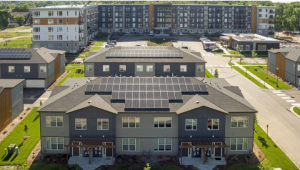The latest Humans of Michigan Tech story features Sydney, an undergrad who lives in an ambulance turned tiny home. The story barely touches the surface of the environmental, economic, and personal benefits that can come from tiny home living. Tiny homes are a great example of how environmentally responsible living is also economically beneficial – Sydney doesn’t have to pay rent or utility bills and can take advantage of the shared systems like showers and internet provided by the college campus. Sydney is not the first MTU student to live in a tiny home while completing a degree here – a student who built a tiny home on a trailer used to live in my yard, before she graduated and moved away from Houghton. There have even been discussions of developing a community of tiny houses on campus! Sydney and other students who have lived in tiny homes demonstrate that it’s possible, even in the cold snowy climate of the UP. Her story makes me wonder – How many students would live like this, if provided the opportunity to try? How can we teach more students about this possibility? What are the barriers in our way of making more environmentally and economically sound investments for qualify living through tiny homes and access to shared systems? We’re proud of you, Sydney!





